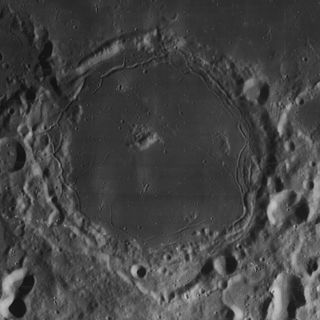
Pitatus is an ancient lunar impact crater located at the southern edge of Mare Nubium. It was named after Italian astronomer Pietro Pitati by the IAU in 1935. Joined to the northwest rim is the crater Hesiodus, and the two are joined by a narrow cleft. To the south lie the attached Wurzelbauer and Gauricus.

Plinius is a prominent lunar impact crater on the border between Mare Serenitatis to the north and Mare Tranquilitatis to the south. Its diameter is 41 km. The crater is named after the Roman natural scientist and author Pliny the Elder. To the south-southeast of Plinius is the crater Ross, and to the northeast is Dawes. Just to the north is a system of rilles named the Rimae Plinius and touching it is the Brackett crater which is more than a crater diameter north. At the northwest edge of the rille is the Promontorium Archerusia, a cape off the western rim that encloses the Mare Serenitatis.

Chacornac is an irregular lunar impact crater attached to the southeast rim of the crater Posidonius. It lies just to the east of the Mare Serenitatis, and north of the crater Le Monnier. The crater is named after French astronomer Jean Chacornac.
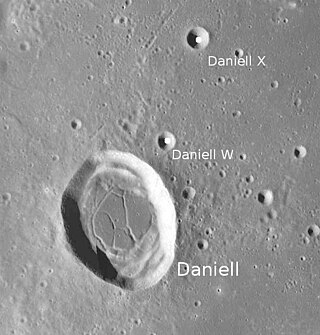
Daniell is a lunar impact crater located in the southern half of the Lacus Somniorum. To the south-southeast is the much larger crater Posidonius. The Rimae Daniell rille system are to the west of Daniell crater.

Dawes is a lunar impact crater located in the wide straight between Mare Serenitatis and Mare Tranquilitatis. To its southwest lies the larger crater Plinius, and to its northeast sits the Mons Argaeus mountain rise. It is named after British astronomer William Rutter Dawes.
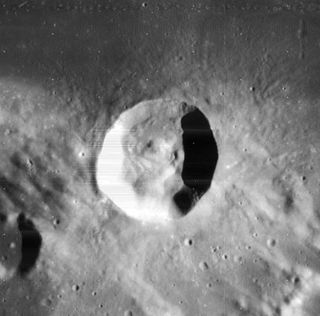
Menelaus is a young lunar impact crater located on the southern shore of Mare Serenitatis near the eastern end of the Montes Hæmus mountain range. Its diameter is 27 km. To the southwest is the small crater Auwers, and to the west-southwest is the even smaller Daubrée. To the northeast is a faint rille system named the Rimae Menelaus.

Brackett is a small lunar impact crater that lies near the southeast edge of Mare Serenitatis. The crater is named after American physicist Frederick Sumner Brackett. The crater has been covered by lava flow, leaving only a ring-shaped trace in the surrounding lunar mare. This crater is best observed under oblique illumination, as it is otherwise difficult to find. The southern rim is almost contacting a rille system named the Rimae Plinius.

Ramsden is a lunar impact crater located on the western stretch of the Palus Epidemiarum. It was named after British instrument maker Jesse Ramsden. To the east-southeast is the crater Capuanus, and to the north lies Dunthorne.

Clerke is a tiny lunar impact crater named after Irish astronomer Agnes Mary Clerke, who played a role in bringing astronomy and astrophysics to the public in Victorian England. It is located near the eastern edge of Mare Serenitatis in the midst of a rille system named the Rimae Littrow after the crater Littrow to the east. It is roughly circular and cup-shaped, with a relatively high albedo. In a valley to the southeast is the landing site of the Apollo 17 mission. Clerke was previously designated Littrow B.

Goclenius is a lunar impact crater that is located near the west edge of Mare Fecunditatis. It lies to the southeast of the lava-flooded crater Gutenberg, and north of Magelhaens. To the northwest is a parallel rille system that follow a course toward the northwest, running for a length of up to 240 kilometers. This feature is named the Rimae Goclenius.

Hippalus is the remnant of a lunar impact crater on the eastern edge of Mare Humorum. It was named after ancient Greek explorer Hippalus. To the southeast is the crater Campanus, and to the northwest is the small flooded crater Loewy.

Littrow is a lunar impact crater that is located in the northeastern part of the Moon's near side, on the east edge of Mare Serenitatis. Its diameter is 29 km. The crater is named after Bohemian astronomer Joseph Johann von Littrow (1781–1840). Some distance to the northeast is the prominent crater Römer, while to the south is Vitruvius.

Prinz is the lava-flooded remains of a lunar impact crater on the Oceanus Procellarum. It was named after German-Belgian astronomer Wilhelm Prinz. The formation lies to the southwest of the prominent crater Aristarchus. To the north-northeast is the flooded crater Krieger.

Sulpicius Gallus is a small, bowl-shaped lunar impact crater that lies near the southwestern edge of the Mare Serenitatis. The crater is named after the 2nd century BC Roman astronomer Gaius Sulpicius Gallus.

De Vico is a small lunar impact crater that is located in the southwest part of the Moon, to the south of the crater Sirsalis. To the west-northwest is Crüger. De Vico is a circular, bowl-shaped formation with a small, flat bottom at the midpoint. To the northwest is the lava-flooded remains of De Vico T. Beyond is a linear rille designated Rimae Sirsalis that follows a path to the northeast past the rim of Sirsalis.
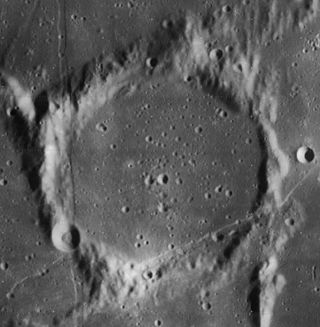
Parry is a lunar impact crater that is attached to the southeast rim of the walled plain Fra Mauro. It was named after British explorer William Parry. Attached to the west and southwest rim of Parry is the crater Bonpland. Due south of Parry is the small crater Tolansky, and farther to the south-southwest is Guericke.
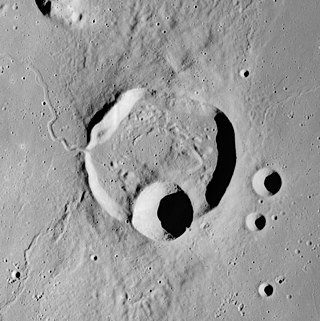
Krieger is a lunar impact crater on the eastern part of the Oceanus Procellarum. It is located to the north-northwest of the flooded crater Prinz, and north-northeast of the prominent ray crater Aristarchus. To the northwest lies the small Wollaston. The crater was formally named in 1935.

Campanus is a lunar impact crater that is located on the southwestern edge of Mare Nubium. It was named after Italian astronomer Campanus of Novara. It forms a crater pair with Mercator just to the southeast. Along the southern rampart of Campanus is the small lunar mare named Palus Epidemiarum. To the southwest is the small crater Dunthorne.
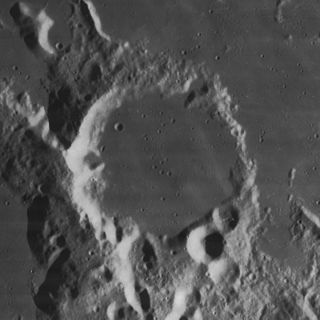
Capuanus is a lunar impact crater that lies along the southern edge of the Palus Epidemiarum. It was named after Italian astronomer F. Capuano di Manfredonia. The outer rim is eroded and indented by lesser crater impacts, with notches in the north, west, and southern parts of the rim. The interior floor has been resurfaced by basaltic lava, which is connected to the surrounding lunar mare by a narrow, crater-formed gap in the northern rim. Dotting the floor of the crater are a number of domes, which are believed to have formed through volcanic activity.

Maclear is a lava-flooded crater on the northwest part of the Mare Tranquillitatis, a lunar mare in the eastern half of the Moon. Its diameter is 20 km. The crater is located to the southwest of the slightly larger Ross. To the southwest of Maclear is Sosigenes, while farther to the south-southeast is Arago.
























